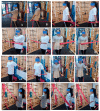Effects of Different Types of Contraction Exercises on Shoulder Function and Muscle Strength in Patients with Adhesive Capsulitis
- PMID: 34948688
- PMCID: PMC8701388
- DOI: 10.3390/ijerph182413078
Effects of Different Types of Contraction Exercises on Shoulder Function and Muscle Strength in Patients with Adhesive Capsulitis
Abstract
Although several studies have reported the effect of exercise therapy for adhesive capsulitis (AC), studies on the comparison of different exercise types on shoulder muscle strength and function in patients with AC are lacking. This study aimed to investigate the effect of different exercise types on shoulder muscle strength and function in patients with AC. Thirty female patients with AC were categorized into an eccentric contraction exercise group (ECG, n = 15; age, 51.53 ± 4.73 years) and a concentric contraction exercise group (CCG, n = 15; age, 52.40 ± 4.03 years). The participants in each group performed a different exercise program three times per week for 60 min per session for 12 weeks. The range of motion (ROM) of the shoulder joint, visual analog scale, shoulder muscle strength, and Constant-Murley score (CMS) were measured before the intervention and after 12 weeks of the exercise intervention. Shoulder ROM in flexion (increase of 31%) and external rotation (ER) (increase of 54%) showed a significant improvement in the ECG (p < 0.05). Muscle strength in ER was significantly different between the two groups (p < 0.05). Pain severity showed improvement in the ECG (decrease of 61%) after the intervention (p < 0.01). The CMS in the ECG (increase of 48%) showed a greater improvement than that in the CCG after the intervention (p < 0.01). This study showed that eccentric contraction exercise had a more beneficial effect than concentric contraction exercise for improving shoulder muscle strength and function in females with AC.
Keywords: exercise therapy; muscle contraction; muscle strength; recovery of function; shoulder adhesive capsulitis.
Conflict of interest statement
The authors declare no conflict of interest.
Figures




References
-
- Akpinar S., Ozalay M., Hersekli M.A., Ozkoc G., Tandogan R.N. Arthroscopic capsular release for frozen shoulder. Acta Orthop. Traumatol. Turc. 2003;37:213–218. (In Turkish: English Abstract) - PubMed
MeSH terms
LinkOut - more resources
Full Text Sources
Medical

